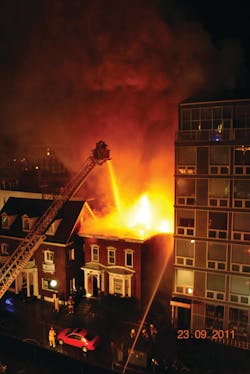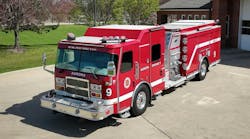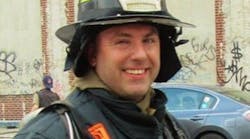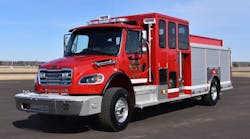On Saturday, Sept. 24, 2011, a four-alarm fire destroyed one historic building and severely damaged another in downtown Iowa City, IA.That the fire was controlled and extinguished with fire spread to only one other building was fortunate considering how close the buildings were to each other. Also, the fact that no firefighters were injured during the operation was a major success. While the Iowa City Fire Department rarely has fires of this magnitude, continuous training, using incident command/management on every scene, and having a mutual aid system, standard operating procedures (SOPs) and standard operating guidelines (SOGs) in place prepared department members to handle almost any situation that confronts them.
The fire destroyed a two-story, type III, ordinary-construction building dating from 1910 with an addition that was built in 1983. The basement contained 2,475 square feet of space used for storage, the first floor contained 3,000 square feet used for retail operations and the second floor contained 2,475 square feet of space divided into four apartments. The building contained single-station, local smoke alarms in the second-floor apartments and hallways.
Units dispatched
The Iowa City Fire Department was dispatched to a reported structure fire at Bruegger’s Bagels at 225 Iowa Ave. at 2:16 A.M. The fire was initially reported by a resident of a second-floor apartment reporting an odor of smoke. Responding on the initial alarm were Engines 1 and 22 and Truck 1, a 100-foot aerial platform, under the command of Battalion Chief Brian Greer. Based on additional information received by the dispatcher, the remaining on-duty engine, Engine 11, was also dispatched. Thirteen firefighters responded on the initial alarm.
The crew members of the first-arriving unit, Engine 1, observed a heavy, black column of smoke above the building. Engine 1 was positioned at the A/D corner of the building on Iowa Avenue. Engine 1 was supplied with a 150-foot, five-inch line from a University of Iowa hydrant. Truck 1 was positioned behind Engine 1 at the A/D corner of the building. Truck 1 was supplied with a 200-foot, five-inch line from a municipal hydrant on Iowa Avenue, west of the scene. Engine 22 was initially positioned in front of Engine 1 and provided the supply lines used by Engine 1 and Truck 1. Engine 11 was positioned at the intersection of Iowa Avenue and Linn Street.
Three crews were inside the structure performing fire attack and search operations. The three-person crew from Engine 1 advanced a 200-foot, 1¾-inch line to the second floor for possible fire attack and to protect search and rescue operations. Truck 1’s three-person crew was searching on the second floor in conjunction with Engine 1’s crew. Engine 22’s three-person crew advanced a 200-foot, 1¾-inch line from Engine 1 into the ground-level commercial occupancy, Bruegger’s Bagels. Engine 22’s crew encountered flames through an exterior vent and noticed flames inside the rear of the structure and applied water to darken down this area.
Shortly after firefighters opened the exterior door on the D side and entering the structure, a smoke explosion occurred, driving Engine 22’s crew out of the structure and back toward the street. When the smoke explosion occurred, the whole D side of the building disappeared in a smoke cloud along with Engine 1, which was on the street in front of the A/D corner. Greer ordered all crews out of the building and a personnel accountability report (PAR) was initiated by command. Interior operations lasted approximately 12 minutes.
Exposed buildings
The Takanami Restaurant at219-221 Iowa Ave. was the exposure on the D side of the fire building. This two-story building was an ordinary-constructed, taxpayer-style building with commercial occupancies on the first floor and four stories of residential apartments above. It was 20 feet from Bruegger’s. On side C, the Van Patton Building at 9 South Linn St. was a two-story, ordinary-construction building with a flat rubber membrane roof. It was built in 1874 and was listed on the National Register of Historic Places. This building contained a commercial occupancy on the first floor and two apartments on the second floor. This building was four feet from Bruegger’s and extended half the distance to the rear of the fire building. The Iowa City Yacht Club and Studio 13 were in an ordinary-constructed building at 13 South Linn St., three feet from the Van Patton building. The B-side exposure was the Vogel House at Iowa Avenue and South Linn Street. This eight-story building contained a commercial occupancy, AKAR Architecture and Design, on the first floor and 24 apartments on the second through eighth floors. It was separated from Bruegger’s by a four-foot, dead-end alley. This building had a double course of bricks on the side toward Bruegger’s that provided a four-hour fire wall in exchange for the close proximity of the building to the others.
Greer requested a callback of off-dutyIowa Cityfirefighters at 2:35 A.M. Seventeen personnel responded to the scene with Heavy Rescue 4, Engine 33 and Support 1, a personnel carrier.
Additional alarms
Greer requested a second alarm at 2:36 A.M. The Coralville Fire Department responded with Truck 75, a 102-foot aerial platform, and five personnel. The North Liberty Fire Department sent Quint 114, a 75-foot quint, and four personnel. The Solon Fire Department responded with Engine 131 and four personnel. Hills Fire Department dispatched Engine 81 and four personnel.
North Liberty Quint 114 was positioned at the A/D corner of the fire building and set up for aerial master stream operations. This aerial unit was supplied by a 100-foot, five-inch line from Iowa City Engine 1. One additional 200-foot, 1 ¾-inch line was deployed from Quint 114 for exposure protection.
Coralville Truck 75 was positioned on South Linn Street and set up for aerial master stream operations, supplied by a relay operation from Solon Engine 131. This unit provided aerial operations to exposures on South Linn Streetand on side C of the fire building. Solon Engine 131 was positioned on South Linn Street, south of Coralville Truck 75, and fed by a 200-foot, five-inch line. This engine supplied a ground monitor with a 150-foot, 2½-inch line and several handlines on South Linn Street for exposure protection.
Greer requested a third alarm at 2:39 A.M. This brought to the scene Lone Tree Fire Department Engine 91, Swisher Fire Department Engine 141, Tiffin Fire Department Engine 151 and West Branch Fire Department Engine 191, each with four personnel. All third-alarm apparatus was staged on Iowa Avenue and crews were assigned to firefighting operations.
Defensive operations
The defensive attack was initiated at 2:51 A.M., shortly after the smoke explosion occurred in the commercial area of the building. Once the fire had breached the C/D corner of the building, command questioned the structural integrity of the building, so operations went defensive.
Engine 1 placed its deck gun into operation to protect the exposure on the D side of the structure. Truck 1 operated its elevated master stream on both the fire building and the Vogel House (the side-B exposure). Engine 22 was repositioned to the alley on the C side of the building and supplied by a 250-foot, five-inch line from a hydrant on Dubuque Street. Crews deployed a ground monitor supplied with 200 feet of 2½-inch hose in the courtyard of side C. This engine also supplied a 200-foot, 2½-inch line that was advanced to the roof of the yacht club and two 200-foot, 1¾-inch lines into the interior of the Yacht Club.
Command requested a fourth alarm at 4:26 A.M. The Oxford, Riverside and West Liberty fire departments each responded with an engine and crew to backfill city stations in the event of another call.
Operations Chief Brian Rohr declared the fire under control at 7:30 A.M. Mutual aid departments began being released at 7:55 A.M. The last Iowa City unit left the scene at 2:11 P.M., nearly 12 hours after the initial alarm. Fire Marshal John Grier and investigators Ben Stammeyer, John Rockensies and Brian Sobaski remained on the scene to start the fire investigation and maintain scene security.
Seventy-five firefighters operated three engines, two aerial platforms, one quint and a heavy rescue to control the fire. Firefighters used 900 feet of five inch supply line, 1,000 feet of two and one half inch hose and 1,200 feet of one and three quarter inch attack line. Three municipal hydrants and one University hydrant supplied over 600,000 gallons of water used to extinguish the fire. Damage to the buildings was estimated at $680,000 and $650,000 to the contents.
Fire investigation
The initial origin-and-cause investigation was conducted over two days, Sept. 24 and 25. Fire investigators from the Iowa City fire and police departments worked into the early evening on the day of the fire. The scene was held overnight and investigators concluded their investigation the following afternoon.
Access to the interior of the building was difficult due to the severe damage sustained by the structure. Fire department personnel secured all entrances, set up temporary fencing and then released the property to a company representative. Subsequent joint scene examinations with representatives for parties with an interest were held on Oct. 4, 7, 8, 9, 13 and 14. Scene artifacts were collected during the examinations and secured by the engineering firm hired by Bruegger’s insurance carrier to coordinate the scene investigation. A joint examination of artifacts was conducted on Nov. 17 and 18 and on Jan. 9, 10, 11, 12 and 13. The room of origin was determined to be the kitchen of the Bruegger’s restaurant. The cause of the fire remains undetermined.






